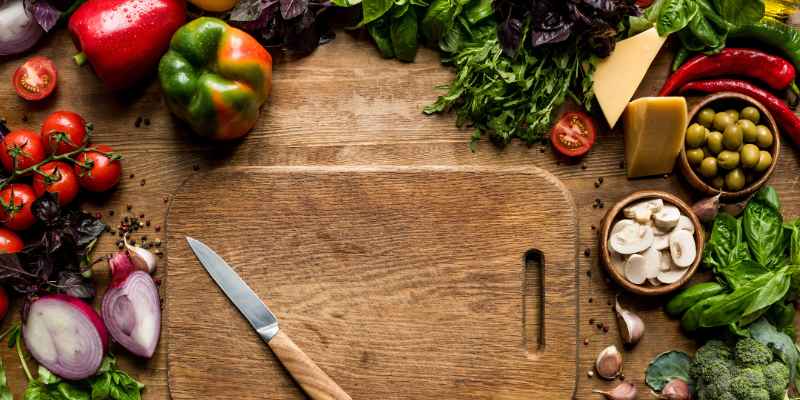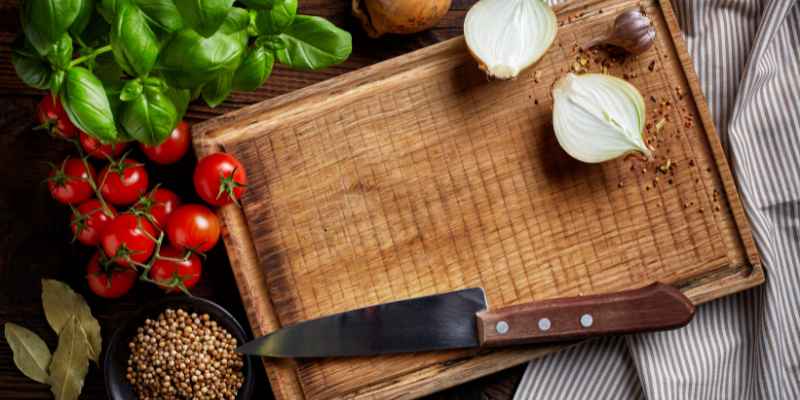Cedar cutting boards are food safe as long as they are properly maintained and sealed. Cedar wood has natural antimicrobial properties that help to inhibit the growth of bacteria.
Additionally, the tight grain of cedar wood helps to minimize the absorption of liquids and odors, making it a suitable choice for food preparation surfaces. However, it is important to note that cedar can sometimes impart a strong aroma and taste to food, so it may not be ideal for all types of cuisine or personal preferences.
Overall, cedar cutting boards can be safe and hygienic options for your kitchen, but it is crucial to follow proper cleaning and maintenance practices to ensure their longevity and food safety.
Benefits Of Cedar Cutting Boards
When choosing a cutting board, one material that often stands out is cedar. Not only does it add a touch of natural beauty to your kitchen, but it also offers a range of benefits that make it an excellent choice for food preparation. Let’s take a closer look at some of the key advantages of using cedar cutting boards.
Natural Antimicrobial Properties
Cedar cutting boards are known for their natural antimicrobial properties, which help prevent the growth of bacteria on the surface. Cedar contains natural oils that act as a defense mechanism against bacteria, making it a hygienic and safe option for food preparation. This natural resistance against harmful microorganisms is an important factor to consider when it comes to maintaining a clean and safe kitchen environment.
Enhanced Durability And Longevity
One of the standout features of cedar cutting boards is their enhanced durability and longevity. Cedar is a dense and hard-wearing wood that can withstand heavy use, knife marks, and scratches. The natural oils in cedar also provide a protective barrier, preventing moisture from penetrating the wood. This durability ensures that your cedar cutting board will remain in excellent condition for years to come, making it a worthwhile investment for your kitchen.
Moreover, cedar cutting boards are resistant to warping and cracking, even with constant exposure to moisture. This ensures that your cutting board remains sturdy and flat, providing a reliable surface for all your food preparation needs.
Additionally, the natural aroma of cedar adds another level of appeal to these cutting boards. The pleasant scent can enhance the overall cooking experience and leave your kitchen smelling fresh.
In conclusion, choosing a cedar cutting board offers not only aesthetic beauty but also several practical benefits. The natural antimicrobial properties and enhanced durability make it a hygienic and long-lasting option for your kitchen. So why not add a touch of elegance and functionality to your culinary endeavors with a cedar cutting board?

Potential Risks Of Cedar Cutting Boards
Cedar cutting boards may pose potential risks as cedar is not considered food safe due to its natural oils. These oils can transfer onto food and potentially cause reactions or affect the taste. It is recommended to choose a different type of wood for a food-safe cutting board.
Cedar cutting boards are known for their attractive appearance and natural antimicrobial properties, making them a popular choice among home cooks and professional chefs alike. However, it’s important to be aware of the potential risks associated with using cedar cutting boards in your kitchen. While cedar is generally considered safe for food preparation, there are a few factors to consider before using a cedar cutting board.
Transfer Of Cedar Flavor To Food
One concern when using a cedar cutting board is the potential transfer of its distinct flavor to the food being prepared. Cedar has a strong aroma that can infuse into ingredients, altering their taste and potentially overpowering the flavors of the dish. This can be particularly problematic when using a cedar cutting board for more delicate ingredients such as fruits or vegetables.
Maintenance And Care Precautions
Proper maintenance and care of cedar cutting boards is essential to ensure their longevity and to minimize any potential risks. Unlike other types of cutting boards, cedar requires specific attention to maintain its quality and food safety standards. Here are a few precautions to keep in mind:
- Cedar cutting boards should be thoroughly washed with hot, soapy water after each use. Avoid using harsh cleaners or abrasive scrubbers that can damage the wood.
- It’s important to dry cedar cutting boards thoroughly to prevent moisture absorption and potential mold growth. Air drying on a clean, dry surface is recommended.
- Regularly oiling cedar cutting boards with food-grade mineral oil helps to maintain their moisture content and prevent cracking or warping. This should be done every few months or as needed.
- Never soak a cedar cutting board in water or expose it to excessive heat, as this can cause the wood to swell or warp, making it unsafe for use.
By following these maintenance and care precautions, you can ensure that your cedar cutting board remains safe for food preparation and prolong its lifespan.
Understanding Food Safety Standards
Discover the importance of understanding food safety standards when using a cedar cutting board. Find out if cedar is food safe and learn how to ensure your kitchen tools meet the necessary requirements to keep your meals safe and hygienic.
When it comes to food preparation, ensuring that your cutting board is food safe is crucial. Food safety standards are put in place to protect consumers from the risks of foodborne illnesses and contamination. When using a cedar cutting board, it’s important to understand what makes it food safe and how it adheres to these standards. In this article, we’ll delve into the factors that contribute to a cutting board’s food safety, as well as the common food safety certifications you should look for.
What Makes A Cutting Board Food Safe?
A food-safe cutting board is one that minimizes the risk of bacterial growth and cross-contamination. Here are some key factors that contribute to the food safety of a cutting board:
- Material: The type of material used in the cutting board plays a crucial role in its food safety. Certain materials, like cedar, have natural antimicrobial properties that inhibit the growth of bacteria.
- Surface Texture: The surface of the cutting board should be smooth, as bacteria can easily hide and multiply in crevices and grooves. A smooth surface also makes it easier to clean and sanitize.
- Size and Thickness: The size and thickness of the cutting board can affect its functionality and cleanliness. It should be large enough to accommodate the items being chopped, but not too bulky to handle or store properly.
Common Food Safety Certifications
To ensure that your cutting board meets food safety standards, look for the following common certifications:
| Food Safety Certification | Description |
|---|---|
| NSF | The NSF certification ensures that the cutting board complies with strict sanitation and safety standards. It verifies that the product is non-toxic and safe for food contact. |
| FDA | The FDA certification indicates that the cutting board meets the regulations set by the Food and Drug Administration. It ensures that the product is safe and suitable for its intended use. |
| HACCP | The HACCP certification stands for Hazard Analysis and Critical Control Points. It certifies that the cutting board has undergone a comprehensive risk assessment and follows specific safety procedures to prevent contamination. |
By choosing a cutting board that meets these certifications, you can have peace of mind knowing that it has undergone rigorous testing and adheres to strict food safety standards.
Remember, when it comes to food safety, the material, surface texture, size, and thickness of the cutting board are important factors to consider. Additionally, looking for common food safety certifications like NSF, FDA, and HACCP can further ensure that your cutting board is safe for food preparation. Prioritizing food safety not only protects your health but also enhances the overall quality of your cooking experience.

Expert Recommendations For Cedar Cutting Boards
When it comes to choosing a cutting board for your kitchen, cedar is a popular choice among many home cooks. However, before you invest in a cedar cutting board, it’s crucial to understand its food safety and maintenance. In this section, we will share expert recommendations for using cedar cutting boards.
Proper Usage And Cleaning Techniques
Proper usage and cleaning techniques are essential to ensure the longevity and safety of your cedar cutting board. Here are expert recommendations:
1. Season your cedar cutting board
Before using your cedar cutting board for the first time, it’s important to season it properly. Apply a food-grade finishing oil, such as mineral oil or beeswax, to all surfaces of the board. This helps to seal the wood, prevents moisture absorption, and enhances its durability.
2. Use separate cutting boards
To avoid cross-contamination and maintain food safety, it is advisable to use separate cutting boards for different types of ingredients. Dedicate a cedar cutting board for fruits and vegetables and another one for raw meat, poultry, or fish. This minimizes the risk of bacterial growth and prevents flavor transfer between ingredients.
3. Avoid cutting acidic foods
Cedar is not suitable for cutting acidic foods like citrus fruits or tomatoes. The natural oils present in cedar can react with acids and impart an undesirable flavor to your food. Opt for other cutting boards, such as plastic or glass, when working with acidic ingredients.
4. Hand wash only
Last but not least, always wash your cedar cutting board by hand. Avoid soaking it in water or putting it in the dishwasher, as excessive exposure to moisture can damage the wood and cause warping. Use a mild dish soap, warm water, and a non-abrasive sponge to clean the board thoroughly after each use. Pat dry with a clean towel and let it air dry completely before storing.
Alternatives To Cedar Cutting Boards
If you’re concerned about using cedar cutting boards or looking for alternatives, here are some options to consider:
1. Bamboo cutting boards
Bamboo cutting boards are an excellent alternative to cedar. They are durable, eco-friendly, and naturally antimicrobial. Bamboo is a fast-growing grass that offers a hard surface for cutting, similar to hardwood, making it a popular choice among many home chefs.
2. Plastic cutting boards
Plastic cutting boards are lightweight, affordable, and easy to clean. They come in a variety of sizes, colors, and thicknesses, allowing you to choose the one that suits your needs. Look for high-density polyethylene (HDPE) or polypropylene (PP) plastic cutting boards, as they are non-porous and resistant to bacteria.
3. Glass cutting boards
Glass cutting boards are hygienic, non-porous, and provide a sleek surface for cutting. They are also heat-resistant and can be used as a serving platter, making them a versatile option for your kitchen. However, keep in mind that glass cutting boards can dull your knives faster compared to other materials.
In conclusion, while cedar cutting boards can add aesthetic appeal to your kitchen, it’s crucial to follow expert recommendations for their proper usage and cleaning. Alternatively, you can explore other options like bamboo, plastic, or glass cutting boards based on your preferences and needs.
Conclusion
To conclude, cedar cutting boards are indeed food safe due to their natural antimicrobial properties, which can help prevent the growth of bacteria on the surface. With its durability and rustic appeal, a cedar cutting board can be a great addition to any kitchen.
Remember to properly clean and maintain your cedar cutting board to ensure its longevity and food safety. Opting for a high-quality cedar cutting board is a smart choice for your culinary endeavors.


